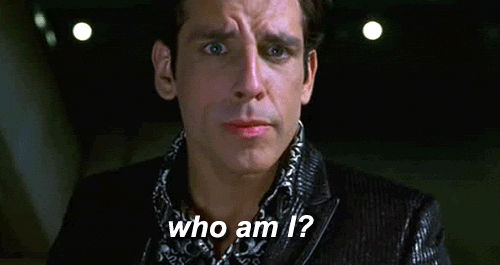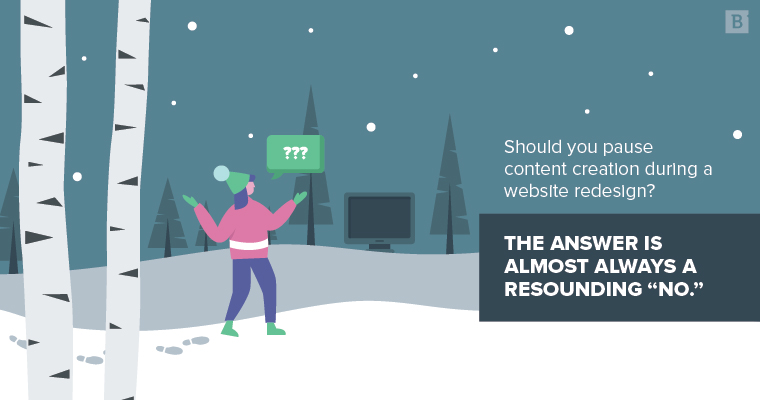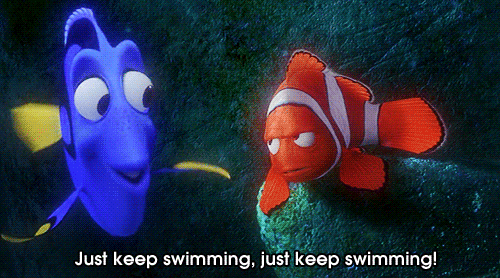A website redesign project is not for the faint of heart. It’s a colossal undertaking that usually requires all hands on deck, from developers to writers to senior leaders. That means less time and attention given to other priorities, which, when creatives are involved, means the normal content creation process could be seriously disrupted.
Of course, website redesigns are often essential to businesses that want to evolve and stay relevant (which is just about all of them). That means you have to find a way to manage your content creation during a website redesign to limit the disruption as much as possible.
As with most things, that’s easier said than done. You need to balance the needs of your business with the requirements of your redesign project, while making sure you keep your content production line relevant and fruitful. And there are some (rare) cases in which you actually should pause your content creation (we’ll talk more about those later).
Why a Website Redesign?
If a website redesign is such a headache, why take it on? It’s simple. Have you ever landed on a website that looks like it hasn’t been updated since 2003? What words pop into your head? (For me, it’s ‘outdated,’ ‘behind the times’ and ‘possibly out of business.’ In short, nothing good.)
Websites need to be continually updated because consumers are evolving organisms. Their tastes, preferences and interests are always changing, and your website has to reflect those changes to stay relevant. An outdated website with a bad user experience signals to site visitors that your brand is unable to keep up, and that hurts your ability to build rapport with them.
When initiating your website redesign, consider the following elements:
- Tone of voice.
- Font.
- Images.
- Copy.
- Graphics.
- Calls to action.
- Page layout.
A website redesign is a major project, and we could probably draft an entire manifesto about it. But don’t worry, we’ll spare you your afternoon. Instead we’ll give you the Cliff Notes in six steps:
6 Steps for Content Creation During a Website Redesign
Every successful site redesign starts with a sound plan. The following six steps will help you tackle your redesign with confidence.
1. Audit, Audit, Audit
A painstaking process that’s necessary to figure out what’s working, what’s just wasting space and what’s altogether missing from your site. What’s weak about your SEO strategy? Where are you missing opportunities to generate and/or convert leads? Free tools such as Google Analytics can go a long way toward helping you answer these questions.
You can also conduct a conversion rate optimization (CRO) audit as part of your broader content audit. A CRO audit gives you insights into the elements of your pages that are preventing goal conversions. Weak calls to action, a poor user experience and mismatched content hierarchy can all make it difficult for website visitors to complete your intended actions. This information can give you helpful insights as you plan and structure your new site.
2. Perform Some Serious Competitive Analysis
Make sure you’re also researching the competition and performing keyword analysis with a resource such as SEMrush, Google Keyword Planner and KW Finder. Find out who’s doing what well, and how your new digital branding will level the playing field for your business. Other good questions to ask: Does the competition have an online store? Are they linking directly to their channel partners? What keywords are they dominating?
Use these first two phases to establish website performance benchmarks such as overall SERP rankings, website traffic, traffic sources, bounce rate and conversion. Know where you are, figure out where you want to be and begin planning how you’ll get there.
3. Map Out Brand Guidelines
Assuming this isn’t just a quick spruce up, we highly recommend that you ideate your new brand vision with as much specificity as possible. From brand colors, to iconography, to design motifs (e.g., material design) to the tone and style of your copy. And if this is a more fundamental business shakeup (which we’ll get into later), the more you know about this new brand identity (what’s its favorite food? Is it a dog or a cat person?), the better.

Don’t shortchange your brand identity. Branding is absolutely essential for businesses who often interact with customers across multiple digital channels. Your brand identity needs to be uniquely you — it needs to support your vision and mission while reflecting the way you want to interact with potential customers. Most importantly, it needs to be highly consistent across all of your online collateral.
Customers need to feel that whenever they’re engaging with one of your online assets — whether that’s a landing page, blog or social media post — they’re actually interacting with your brand. It needs to look, feel and sound like you.
4. Create Your Timeline for Execution
Simply put, scope out a timeframe that identifies the order you’ll be tackling certain webpages and estimates the associated costs. Focus first on the highest-priority webpages of your current website. While your homepage will be an obvious early candidate in the redesign process, make sure to have a conversation with your sales teams and other key stakeholders to determine which product pages are next up for reboot.
Of course, giving all your early attention and energy to your most important pages runs the risk of losing steam as you move further down the list. Make sure all direct stakeholders understand their roles and responsibilities regarding your timeline, and ensure you have mechanisms in place to keep all parties accountable for delivery and execution.
5. Let the Content Creation Begin
Start with the actual copy, because it’s so important to nail your messaging if you want to create a design that accentuates the point. Not to mention, this website content needs to be precise and it needs to be optimized for search engines. It will live on your website until the next refresh, so don’t be afraid to take extra time to get the messaging just right.
Remember: Core landing pages (homepage, products and service pages that live in the top navigation) serve as the foundation of your website from which everything else should be built around. They’re the pillars of your search presence, and as such, should take top order of priority. They should drive the majority of traffic (depending on how well you target keywords and the quality of your content) and are also the hardest to change down the road. This content needs to be solid before designing.
Take the time needed to appropriately plan your website content. Consider the user experience and design your content hierarchy around that. When website visitors land on your page, what information do you want them to see first? Where will this copy lead them next in the site journey? What is the intended action of each page?
This last question is key — writing great website copy is about more than just putting all the important information on a single page; it’s about writing in a way that encourages deeper engagement with not only your page, but also your website and organization. Design a thoughtful customer journey that leads customers directly to your eventual call to action (which should be page appropriate), and include strategically placed hyperlinks throughout the page to lead visitors to other destinations on your site.
6. Commence With Website Design Mockups
From a performance perspective, the most critical piece of advice is this: Always, always use responsive web design. This refers to UX and design strategy by which your webpages automatically adjust to fit the user’s screen. Google really cares about this and is slowly moving over to a mobile-first indexing system.
Again, these steps represent a high-level overview of what’s involved in a website redesign. The deeper you dive into the nuances, the clearer the enormity of the task becomes.
But this post isn’t intended as a detailed, step-by-step guide on how to redesign your website (that’s a discussion for another time). Rather, it addresses another issue associated with a website redesign, which is how to handle content creation during the above processes.
And while we’ve found that many organizations tend to struggle with this question, the answers, which are revealed below, are actually really straightforward.
So …

Should You Ever Pause Content Creation?
The answer is almost always a resounding “no” and here’s why:
Let’s say you have a blog post or some sort of existing resource center on your website that you regularly update (and if you don’t, we hate to say it, but you have a lot of catching up to do). Letting your blog and/or resource center atrophy is incredibly risky for several reasons:
- Each new blog post is a new page that Google indexes. Slow down your posting, and you may miss out on new opportunities to rank and to be discovered in SERPs
- Google likes a website that updates frequently. This absolutely doesn’t mean you should focus on quantity over quality (searcher intent is hugely important). Nevertheless, 75 percent of the most successful B2B marketers deliver content frequently, according to the Content Marketing Institute, and there’s good reasons for that (in fact, several of them are on this list).
- Your content drives much of the discussions you’re having on social media (or at least it should). The last thing you want is for your social engagement to drop off in response to a content drought.
- Likewise, content is the lifeblood of your email marketing campaign. Firstly, it’s often how you capture emails to actually get a certain prospect in the drip. Secondly, content is a great way to break the ice and start conversations over email. Whether it’s a newsletter, a “how to” blog post, or a comprehensive eBook, you have to keep your contacts list engaged if you expect to see ROI on email marketing.
- Regular content production also demonstrates to potential customers that your brand is consistent and reliable. You don’t just post one blog article and run for the hills; you regularly provide customers with insights, solutions and valuable information they can use to solve problems every single day. It’s that level of reliability that builds trust in your brand.
An alternative scenario might be that you’re launching a brand new resource center, in which case, the more content you have ready upon initial launch, the better. You’ll need plenty of assets ready to promote over social, email and other marketing channels to hit the ground running and build an initial base of interest for your blog or resource center.
As taxing as it may be to keep creating content while planning an extensive redesign that has you spread thin, taking the foot off the gas is a strategic misstep to be avoided.

With One Exception …
And that’s if you’re completely and fundamentally redefining your messaging and your business.
If your organization is undergoing a significant transformation and you’re still in the process of re-defining your product offerings and value propositions, you might actually be wasting time and money if you continue to produce content that aligns with old messaging or the half-baked version of your new messaging. Your content creators will end up pushing out assets that are aligned with your old messaging, meaning all of it will eventually have to be replaced or updated once your new website is live (or, worse, if it’s unsalvageable it will have to be removed entirely).
Under these circumstances, a pause is actually recommended.
But again, don’t slam on the brakes unless you absolutely have to, and you’re certain that you couldn’t possibly create anything of value to your future brand identity in the immediate present. There are plenty of pieces of content you can create that will be relevant to your target audience whether you are pre- or post-site launch.
And as soon as you do have a strong idea about who your company is and how to convey that identity through written word, images, audio and video, get right back on the saddle.
Content is your business’s footprint on the internet. Stop leaving tracks, and your target audience will almost certainly fall off your trail, website redesign or no website redesign.
Want more digital marketing insights like these? Subscribe to “The Content Marketer” to receive a free newsletter packed with content marketing insights, advice and opinions sent straight to your inbox every week.
Updated: October 2022.





